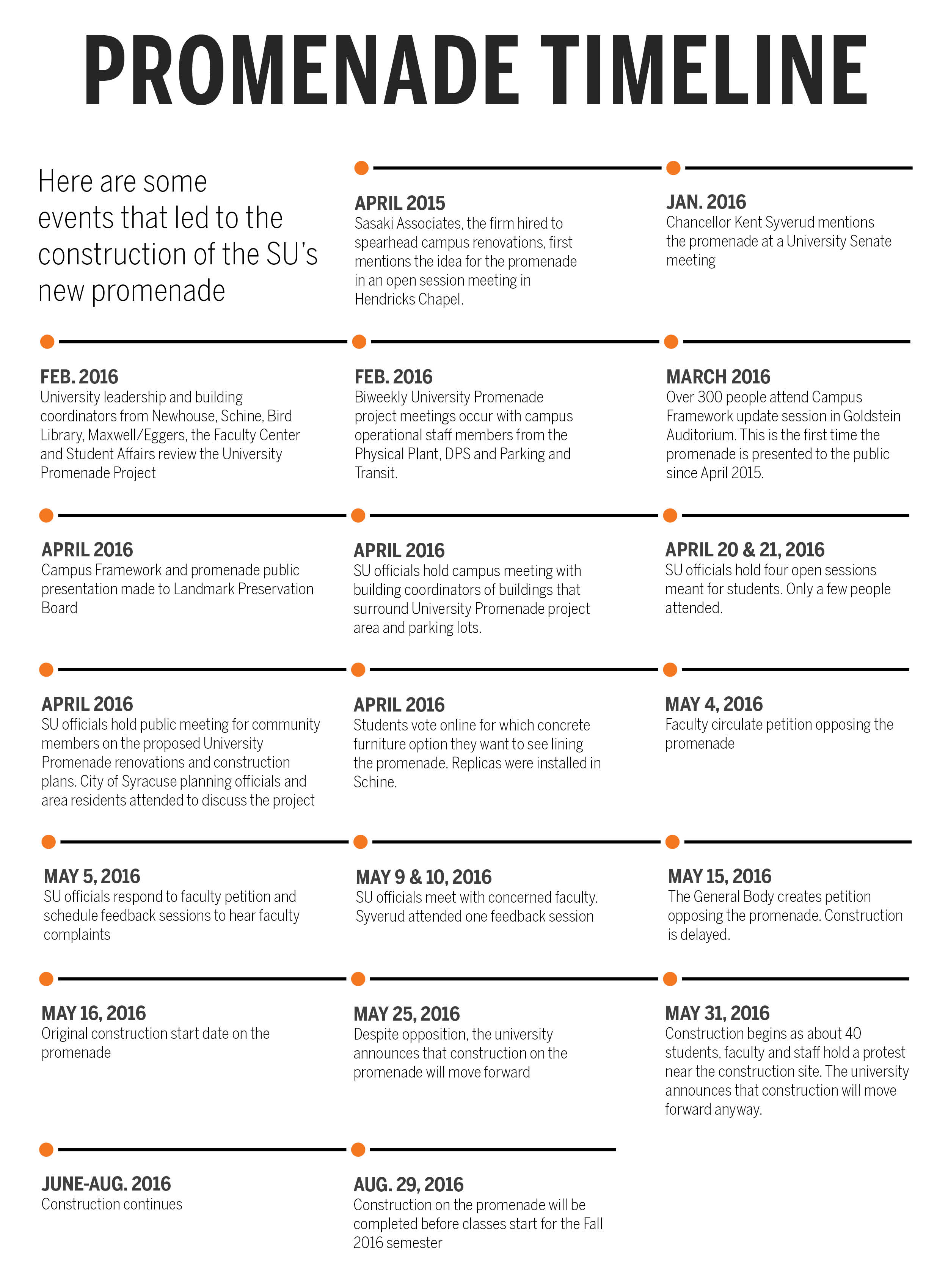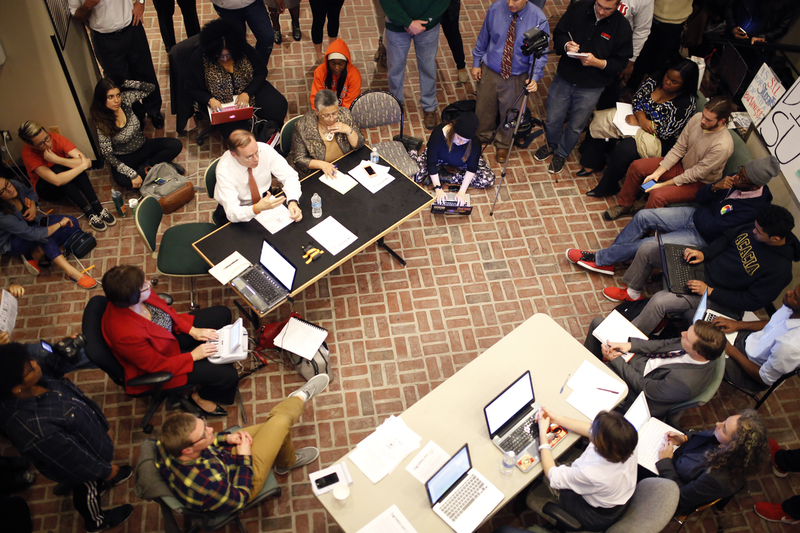Explaining Syracuse University’s controversial University Place promenade
Jessica Sheldon | Photo Editor
Construction on the University Place promenade began on May 31. The promenade was completed on Aug. 22 — one week before classes for the fall semester started.
UPDATED:Oct. 16 at 10:22 p.m.
Last year, Syracuse University undertook a major construction project on University Place — the street in front of the Schine Student Center and Bird Library. The university built a car-free, pedestrian promenade.
The project was one of several major renovations planned as part of the university’s Campus Framework project, a 20-year plan for the physical structure of SU.
A draft of the plan, which included details about the University Place promenade, was released in June 2016, weeks after construction on the promenade had already started. The Campus Framework is one part of Chancellor Kent Syverud’s Fast Forward Syracuse initiative.
The promenade, though, was met with backlash from some faculty, staff and students.
Starting in the weeks leading up to construction in May 2016, the project was mired by complaints about its funding and the administration’s lack of transparency about the project.
Still, despite vocal opposition, the promenade — officially named the Einhorn Family Walk — was completed before the fall 2016 semester began.
Here’s a deeper look into the University Place promenade project and its impacts on and around the SU campus.
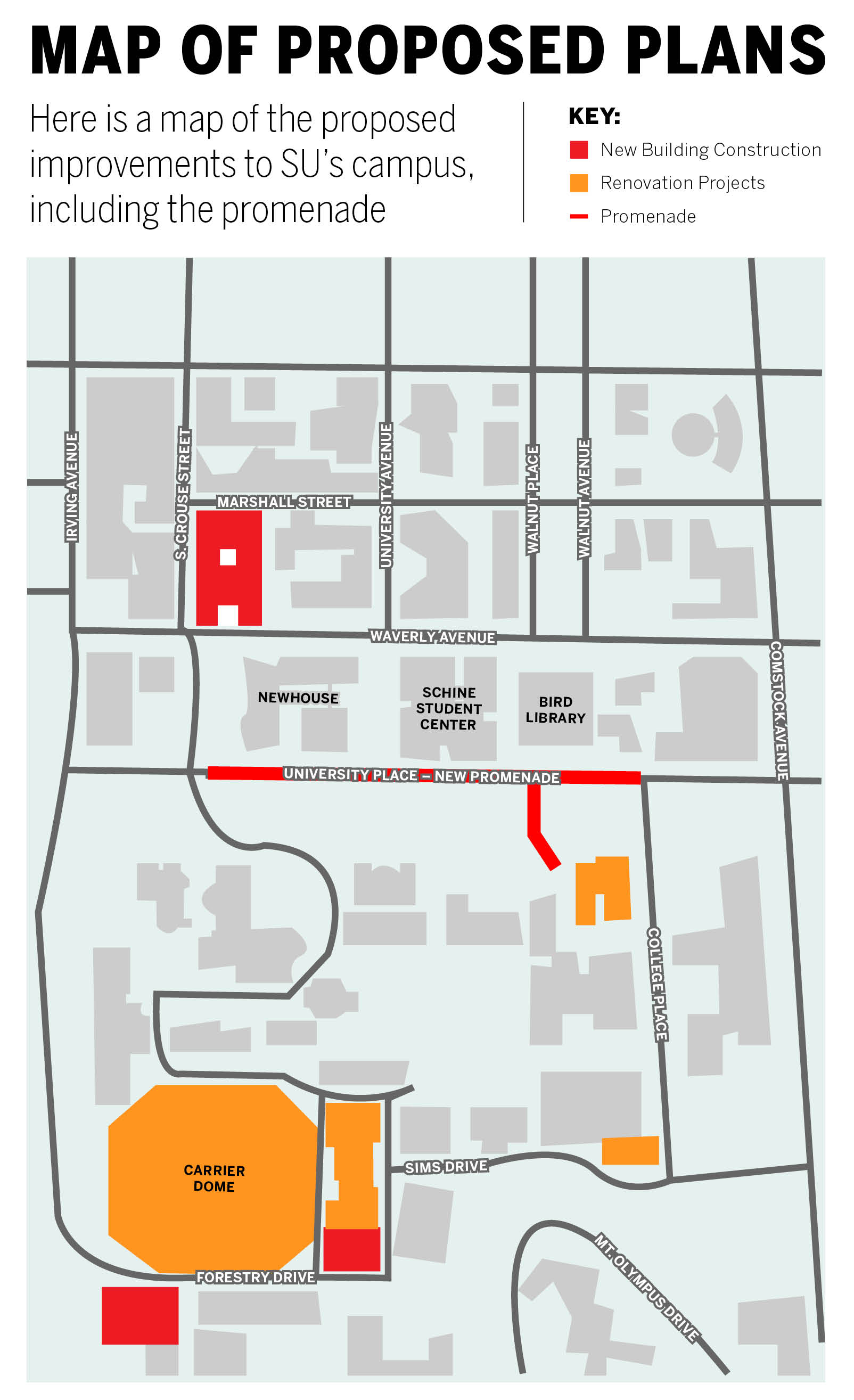 Emma Comtois | Senior Design Editor
Emma Comtois | Senior Design Editor
What’s a promenade anyway?
A promenade is basically a huge sidewalk. The street between South Crouse Avenue and College Place has become a car-free walkway, only allowing emergency vehicles to pass.
There was already one promenade on campus: the path between the S.I. Newhouse School of Public Communications and Schine. That street was converted into a promenade in the 1990s. Before then, people could drive all the way up University Avenue to University Place.
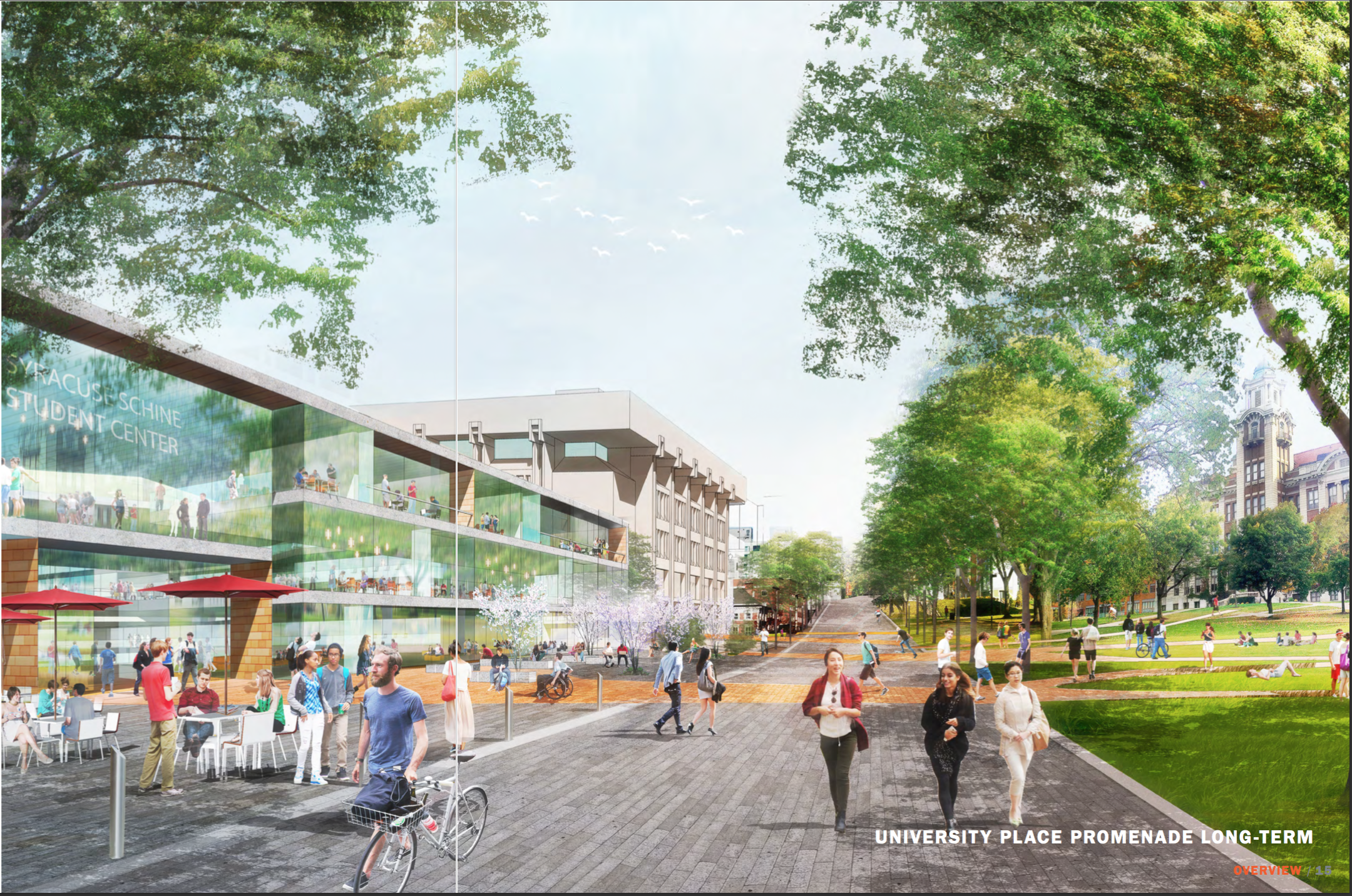 Courtesy of the Campus Framework draft
Courtesy of the Campus Framework draft
Traffic and bus routes will be affected
In the summer of 2016, bike lanes along Waverly and Comstock avenues were modified into a single one-way track. The bus stops on University Place were moved to Waverly and Comstock avenues.
Once the promenade was built, the bus stops in front of Schine and Bird Library were permanently moved to the opposite side of the buildings on Waverly Avenue.
Opponents of the promenade claimed that because the promenade would make University Place unusable to cars, traffic on roads surrounding the promenade would increase.
However, the project required significant preliminary planning and work. Traffic pattern changes were “uneventful,” said Pete Sala, vice president and chief facilities officer.
He added that Centro buses were able to adapt to different timings and routes, creating a more efficient system than the one that existed before.
The promenade will be more than just a sidewalk.
The promenade also has heated sidewalks to help melt snow, a bike rack in front of Bird Library and concrete furniture lining its path.
 Zach Barlow | Staff Photographer
Zach Barlow | Staff Photographer
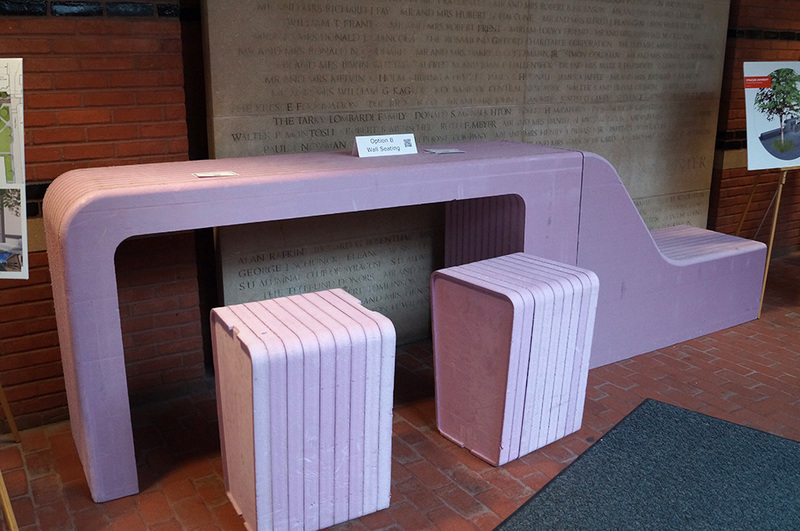 Zach Barlow | Staff Photographer
Zach Barlow | Staff Photographer
Several years before Campus Framework projects began to take shape, SU conducted a campus-wide survey with its design partner, Sasaki Associates, said Cathryn Newton, special advisor to the chancellor and provost for faculty engagement.
One of the overwhelming survey responses was that people wanted more space outside where they could spend time with groups, she said.
Two replicas of different concrete furniture options for the promenade were displayed in Schine during a week in April 2016 for students to look at and sit on. Students could then vote on which option they liked best.
Again in October 2016, four seating options for the walkway were presented to campus community members during an engagement session with Sasaki Associates.
Voting took place in December 2016, through campus-wide emails to students, faculty and staff and a voting table in Schine, said Sarah Scalese, associate vice president for university communications.
The campus community chose granite blocks topped with wooden seating surfaces as part of the furnishing. To facilitate group meetings and conversations, the benches will face each other.
New seating was installed before the beginning of the fall 2017 semester.
The project has been surrounded by controversy… why?
Ten days before construction was scheduled to start on May 16, 2016, a petition against the promenade circulated among faculty members and was eventually sent to Syverud with 108 signatures.
The list of grievances in the petition included concerns about traffic, safety and accessibility, cost and a lack of transparency from the SU administration. In short, those who signed the petition said they felt the money being used to build the promenade should be redirected toward improving academics, a goal in the Academic Strategic Plan — another part of Syverud’s Fast Forward Syracuse initiative.
SU officials responded with an email detailing the university’s public outreach effort as a rebuttal to the claim about the lack of transparency. The email included a fact sheet with a traffic survey from the city to respond to complaints about unsafe traffic levels.
The fact sheet also said the university was doubling down on making sure the promenade and the surrounding areas would be accessible to people with disabilities.
The cost of the promenade was not directly addressed in the email.
SU officials scheduled two open sessions the following week to hear feedback from faculty members who signed the petition. At the two sessions, faculty rehashed their complaints and the administration tried to assuage their concerns, often leading to heated exchanges. Syverud showed up at one of the meetings, but tension still remained.
Then THE General Body weighed in.
The University Place promenade ignited long simmering tensions
THE General body, a coalition of student organizations that staged an 18-day sit-in in Crouse-Hinds Hall in November 2014, sent another petition to Syverud on May 15, 2016, with 246 signatures and additional complaints.
Daily Orange File Photo
For THE General Body, the University Place promenade was another decision the SU administration made without seriously consulting the student body.
The closing of the Advocacy Center, cutting of POSSE scholarships — both of which led to THE General Body’s original sit-in — the changes to graduate student health care and the employee buyout were just a few of the roots of THE General Body’s frustration.
At the heart of THE General Body’s concerns was its belief that the administration had tried to pull the wool over student’s eyes and that the promenade itself was a waste of money.
That money, they argued, should have been used to right some of what people perceive as previous wrongs of the administration by hiring employees back who took the buyout, funding POSSE scholarships, increasing mental health services on campus and paying adjunct professors more.
As a result, THE General Body organized a protest on campus on the same day construction for the promenade began. Since school was out of session for the summer during the protest, only about 40 people showed up, a number vastly lower than the number of signatories on the petition.
 class=”photo-credit”>Daily Orange File Photo
class=”photo-credit”>Daily Orange File Photo
Was the university actually transparent about its plans for the promenade?
One of the first public mentions of the promenade was in April 2015 in an open house given by the architecture firm hired to spearhead campus renovations, Sasaki Associates.
The University Place promenade, along with other elements of the Campus Framework, was presented to about 450 members of the SU community as just ideas at the time, with no timetable given on how long it would take to implement them.
The next public meeting about the promenade wasn’t until nearly a year later in March 2016. More than 300 faculty members attended the open session, but plans for the promenade were still being described as “conceptual” and “speculatory,” and actual designs had not yet been proposed, Michael Speaks, dean of the School of Architecture, said at the time.
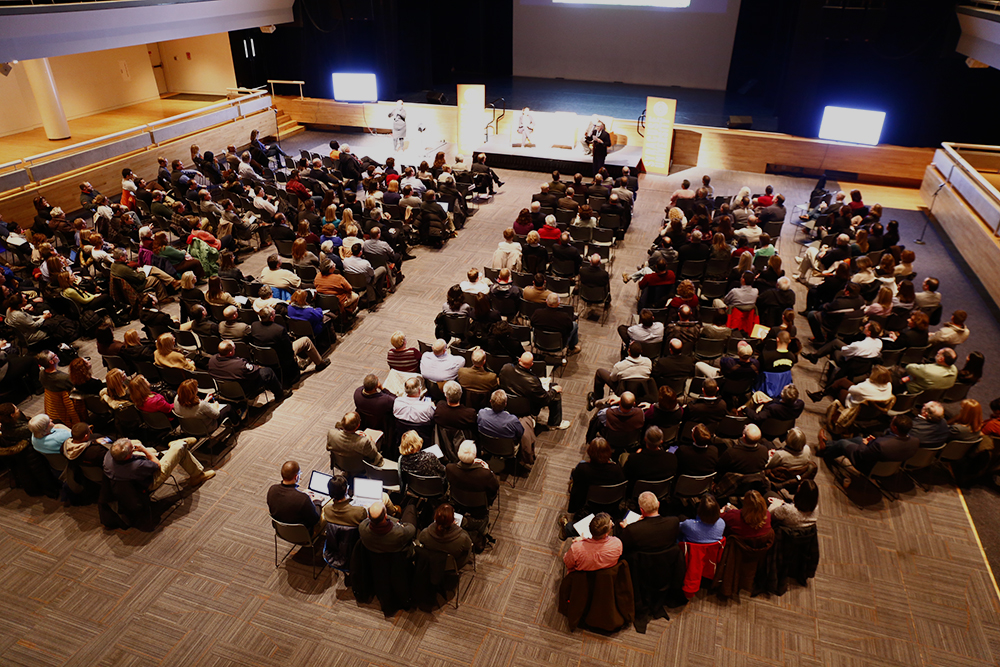 class=”photo-credit”>Michael Santiago | Contributing Photographer
class=”photo-credit”>Michael Santiago | Contributing Photographer
Later that month, SU officials held public meetings with city stakeholders, including with the volunteer-based group Tomorrow’s Neighborhoods Today and the Landmark Preservation Board, though the matter did not appear on the Syracuse Common Council agenda until a few weeks before construction was originally set to begin.
Four public meetings aimed at students were scheduled a few weeks later. Another public meeting was held after that.
Last summer, during the promenade’s construction, the university held information and update sessions about the summer construction and Campus Framework.
The problem with these meetings, critics said, was that few in the SU community went to them or knew they were happening. Ten students showed up to the first open session and two went to the second one. It was never announced that the promenade was out of the conceptual stage until early May, prompting the faculty petition.
Syverud even said in May 2016 at a faculty feedback session that transparency about the promenade was not perfect.
“Neither the communications nor the process of the promenade were as good as they should have been,” Syverud said. “I think we should say that and get over it. We’re not all perfect.”
Additionally, a draft of the official Campus Framework plan — which includes plans for the promenade and other projects around campus as well as a forum to leave comments — wasn’t released until nearly a month after construction on the promenade had already started. This left no official channel for people to voice their concerns about the promenade before construction started.
How is the promenade being funded?
In October 2016, Syverud broke down the cost of the promenade, which totaled $6 million. One-third of the cost went toward a utility project involving water and sewer mains under University Place. The remaining $4 million was allocated for leveling the ground and creating the pedestrian walkway.
Part of the cost was built into the Campus Planning, Design and Construction’s capital project budget, Sala said.
Philanthropic donations are expected to cover $2 million of the cost.
Syracuse University trustees and alumni, Steven and Sherry Einhorn, donated $1 million toward the promenade, which is named after the family.
Philanthropy has played a huge role in funding for multiple Campus Framework projects, said Sarah Scalese, referring also to the $5 million donation from Steve Barnes for the construction of “The Arch.”

Andy Mendes | Digital Design Editor
Changing opinions of the promenade
The original lack of communication and rollout played a part in the public’s negative perception of the promenade, Sala said.
Once communication was fixed, opinions improved, he added. Now, Sala only hears positive things about the promenade from the campus community and visitors to SU, who often stop to take pictures in front of the walkway.
Newton agreed and said the promenade has enlivened a “crucial” area of campus, due to its central location near several academic buildings.
Many of the ideas included in the Campus Framework came from students, faculty and staff, Newton said. She added that the administration builds off of what the campus community wants to see improved at SU.
How is the university dealing with accessibility?
In the fact sheet sent to faculty after the first petition was created, SU officials said accessibility was at the “forefront” of conversations about the promenade and the Campus Framework. The university, it seems, is holding to that.
In weekly emails over summer 2016, Sala provided updates about the various construction projects around campus, including numerous projects that will make dorms and campus buildings around the promenade more accessible.
Campus Framework initiatives to improve accessibility in academic buildings, the Carrier Dome and other places around campus are also continuing during the summer and fall of 2017.
The Daily Orange will continue to update this Explainer as new information about the University Place promenade is released.
Disclaimer: The Daily Orange leases a house on Ostrom Avenue owned by Syracuse University. As part of the Campus Framework, the university has proposed building student housing on Ostrom Avenue where The Daily Orange currently operates.
Published on July 10, 2016 at 12:36 pm
Contact Sandhya: ssiyer@syr.edu


